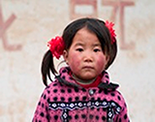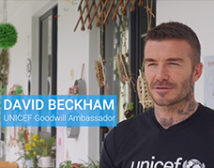Unlike other children of her age, 14-year-old An Xiang doesn't like holidays. "Holidays make me uncomfortable."
Living with her grandparents, An Xiang feels lonely much of the time. "There is nothing to celebrate," she sighs." My childhood has been unhappy."
 ©UNICEF/China/2012/Jerry Liu ©UNICEF/China/2012/Jerry Liu
Anxiang cooks dinner as her grandfather returns from the corn field. Each day she cooks dinner for her grandparents. Children affected by migration face a range of challenges. They are more at risk of abuse and exploitation and they face a higher risk of accidents and injuries. |
When the Child Friendly Space was created near her home three years ago, things started to look up. "My life has brightened up since then." An Xiang said with a smile.
In the aftermath of the Wenchuan earthquake, UNICEF and the National Working Committee on Children and Women set up 40 Child Friendly Spaces in severely affected areas of Sichuan. Now recognized as a powerful tool for the long term psycho-social recovery of children, the Child Friendly Space project has helped over 300,000 children and parents to recover from the disaster.
The innovative model of community based support for vulnerable children has been so effective that 36 of the Child Friendly Spaces have been transformed into permanent development centres for children. They are now fully subsidized by local governments.
The Child Friendly Space that An Xiang frequents is located in Hengxi Village, 180 kilometres south-west of Chengdu. It provides development, participation and protection services for the 800 children living nearby. In addition to a fenced basketball court, there is a brightly-decorated room for young children to play in, a multi-media room that is shared with the village committee and a library cum activity room where the children can gather, play and study.
The CFS is managed by Xiaomei and Juanjuan , two young women in their twenties. They know the children's names and family situations by heart.
From morning till sunset, the door is open to all children. In the morning, grandparents bring their toddlers to the playroom filled with early childhood development tools and games. Around 4 o'clock in the afternoon, schoolchildren come and finish their homework in the library, sometimes with the help of the Child Friendly Space staff. In the course of three years, it has become a haven for the children, and the Child Friendly Space staff among their most trusted companions.
"Xiaomei is my favourite person in the world!" 5-year-old Renxin said, she hides herself completely in Xiaomei's embrace, calling the CFS worker ‘big sister'.
"Juanjuan treats me better than my own parents," 16-year-old Ma Feng said, flushed under the sun of early spring, "I can tell her all my secrets."
It is clear that the Child Friendly Space staffers are both the confidants and mentors of the children. Sometimes, they also need to act as nurses. "Come over Juanjuan, Ren Jun's nose is bleeding!" A boy called, running from the basketball court. Half an hour later, the boy was back on the court with his nose still stuffed with tissues.
The Child Friendly Space model is an example of how post-disaster reconstruction is an opportunity to address pre-existing problems for the long term. The project has now gained a firm foothold in reconstructed communities as service centres for children. The model has also been adopted into China's ten year National Plan of Action for Children.
An Xiang's changes
 ©UNICEF/China/2012/Jerry Liu ©UNICEF/China/2012/Jerry Liu
Child Friendly Space volunteer Yu Yanyong (right) has written a song for the Hengxi CFS. He has formed a small choir and they enjoy performing regularly. The children and youth who benefit from CFS services and activities feel a strong sense of unity and friendship. |
"An Xiang was very quiet and introverted when she first came here," Xiaomei, of the Hengxi Child Friendly Space said.
There is a reason why An Xiang feels shy around other children: she was abandoned by her mother soon after birth. Her father, who has a disability and struggles to find employment, lives in a nearby city and rarely comes home. An Xiang has been seriously affected by migration.
"Almost all children frequenting the Child Friendly Space have one or both parents living away from home," Xiaomei said. The staffers avoid the term ‘left-behind children' for fear of stigmatization.
"In my class (of 25 students), there are only 5 that have both parents at home," said An Xiang, who attends the village middle school.
She carefully chooses the phrase: ‘children whose parents have left for job-hunting in cities' to refer to herself and her peers in similar circumstances.
An Xiang isn't clear what her father does. "He can barely make do for himself, let alone make enough to support me here." She said with a hint of indifference. Her father's role in her life is vague for her. He did not travel home for her recent birthday. "It would be meaningless for him to come home (for my birthday), right?" An Xiang asks ironically.
Before the opening of the Hengxi Child Friendly Space, An Xiang says she had no friends and scarcely anyone to talk to. This is not unusual for children in this situation. "Even though children living with grandparents are fed and clothed, their psychological and developmental needs are not always well addressed." Juanjuan said.
An Xiang's favourite hiding place is the cauliflower field behind her house. "I used to cry my heart out here," the young girl shares, the cauliflower are tall enough to hide her completely.
"It hasn't been easy to open the hearts of the children whose parents have left home. We have made a lot of effort." Xiaomei recounts. The Child Friendly Space organises regular seminars and open day activities for the villagers. In one particular open-day, 50 parents and children joined in the games, enjoying songs and skits organised and created by the children themselves.
In order to encourage more participation, a Children's Committee has been formed. The committee members are chosen by the children themselves, and they range from 12-16 years' old. They are responsible for organising events, carrying out surveys and even conducting home visits. "We run our own affairs," said a proud An Xiang, who is also a member of the Children's Committee in Hengxi.
It turns out An Xiang not only has found her best friends, she has found a whole new direction in life.
"I want to study psychology so that I can help more children like me in the future." She said.
"I remember seeing her three years ago, so quiet, sitting in the corner. Now she's one of the most active members of our Committee," said Yang Haiyu, UNICEF's Child Protection Specialist.
Three years is enough to possibly change the course of life for one child. Yang Haiyu is confident that the Child Friendly Space model will change lives in the future. Following the Sichuan model, by 2011, more than 20 new Child Friendly Space pilot sites were established in Hebei, Jiangsu, Sichuan, Jiangxi, Shanxi, Guangxi, Zhejiang, Fujian, and Anhui provinces, with a focus on reaching especially vulnerable children affected by migration.
"The Child Friendly Space has changed from a temporary project for disaster relief into a permanent government-supported model for children in need. There will be more An Xiang's benefiting from Child Friendly Spaces very soon," Yang Haiyu smiled.
(An Xiang's name has been changed to protect her identity.)
By Liang Ruoqiao






























